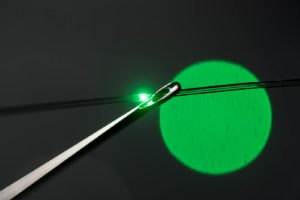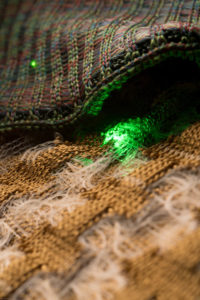
The potential, progress and challenges for next generation smart garments.
Among the many benefits promised by the smart fabric revolution has been the “consumerization of health care.” Wearables are enabling the remote monitoring of a wide range of chronic medical conditions, from diabetes, high blood pressure and congestive heart failure (CHF) to symptoms of disease, discomfort and stress.
First-generation ambulatory devices such as smart wrist watches, strap-on monitors and removable battery packs are slowly being replaced by comfortable, washable garments made of e-textiles that fall into the category of smart fabrics. With the development of new conductive textile fiber technologies, the next generation of smart garments could engender improved wearing compliance, signal accuracy and better health care for millions of consumers.
In 2017, smart fabrics in the medical and health segment had a market size of $97 million, according to IFAI research. A recent report published by the Market Research Future predicts the global medical smart textiles market will register a CAGR of approximately 9.5 percent during the forecast period 2018–2027. Despite the potential, a number of hurdles stand in the pathway between an advanced textile technology’s proof of concept, and consumer level commercialization.

Textile computing
The phrase “textile computing” was coined by Tony Chahine, CEO of Myant, a Canadian company with the goal to “make medical monitoring invisible” by embedding sensors and actuators in everyday textiles. Founded in 2010, the company has focused its research on silver-based conductive yarns. In 2018 Myant opened a Digital Textile Factory in collaboration with knitting machinery maker Stoll, and introduced its SKIIN Smart Underwear for heart health detection (with ECG, HRV, activity, sleep and temperature monitoring).
More recently, Myant announced an agreement with the Mayo Clinic which gave Myant the exclusive license to Mayo Clinic’s proprietary heart monitoring and arrhythmia detection technology for use in textile computing or smart clothing projects.
Launched at 2019’s Consumer Electronics Show, Myant’s SKIIN Smart Shirt with continuous blood pressure monitoring, along with the SKIIN smart underwear line, is scheduled for commercialization this year, pending FDA and Health Canada approval. However, the company has not responded to requests for an update on the status of the project.
No short-cuts to commercialization
Nanowear’s e-textile technology, described by co-founder and CEO Venk Varadan as “a soft, dry sensor that can be integrated into any form factor,” has been 20 years in the making. Since its establishment in 2014, the company has patented the technologies to manufacture and deposit nanosensors on cloth and low energy substrates.
The resulting nanostructures capture what Varadan refers to as a closed-loop “firehose” of medical-grade data which is then transmitted to a printed circuit board (PCB) via conductive fiber. The nanosensor technology increases signal reliability with reduced interference versus standard silver-chloride electrodes. The PCB channels the data to Nanowear’s web-based platform for algorithmic analysis.

In 2016 Nanowear received FDA 510(k) clearance as the first (and only) cloth-based remote cardiac monitoring technology. Since then, the company has been working to develop SimpleSense, a garment for outpatient monitoring of CHF.
Wearable garments offering real-time, cost-effective, wireless, medical-grade monitoring, as opposed to strap-on devices, will increase patient compliance, Varadan believes. “Medicare and Medicaid are excited about the possibility of a low-cost, non-invasive solution for monitoring the health of some 7–10 million patients,” he says.
Nanowear is currently collaborating with partners to build a scaled supply chain, while beginning clinical trials to prove the algorithm. “This is an IoT platform from material science to data analytics; all parties must put it together from a foundational place. Partners and investors have, therefore, been patient,” Varadan advises.
Academic collaborations
A large part of e-textile research and development comes from the collaborative efforts of non-profits and academia. Focusing on e-textiles that will help diagnose amputee comfort, a research team at North Carolina State University (NCSU) Wilson College of Textiles has developed a conductive polymer fiber that can be woven into a fabric structure, forming a sensor array that can be used to monitor the interaction between an amputee and their artificial limb.

The tri-component fiber consists of a conductive polymer in the center, encapsulated in an insulating material to prevent electrical issues, and a third sacrificial polymer which enables the fiber to withstand the commercial melt extrusion process and weaving. When the sacrificial polymer is washed away, the resulting fabric functions as a flexible touchpad, collecting and transmitting continuous data on temperature, humidity, pressure and other factors.
“The inner socket environment for amputees is really uncomfortable,” explains Dr. Tushar Ghosh, professor in the Dept. of Textile Engineering, Chemistry and Science. “We make these fibers using common, low-cost materials, such as nylon; modified to function as sensors. They can be woven, knitted or sewn into a washable sock liner material.”
The project is funded by the NC State Chancellor’s Innovation Fund; the Electrical, Communications and Cyber Systems (ECCS) of the National Science Foundation; and through the Smart and Connected Health program of the National Science Foundation. The monitoring fabric is currently undergoing human trials with volunteers, and the team hopes to patent and license the technology to medical manufacturers for further development and FDA approval.
Smart textiles in transition
A recent article in Textile World by Dr. Raj Bhakta and Dr. Jesse Jur of NCSU Wilson College of Textiles points out that “not all technology sees the light of day in the marketplace.”
The researchers found that the intricacies of manufacturing e-textiles are not compatible with current automation, thus preventing commercial scale-up and lower costs. They concluded that while smart garments will inevitably become part of the value chain of healthcare, “there’s an inherent need for automation to produce these next generation pieces of smart clothing.”

The Advanced Functional Fabrics of America (AFFOA) nonprofit institute was established to do exactly that—bridge the gap that turns research into product. “For years we’ve had great research breakthroughs, written up in journals, that go into libraries where no one ever sees them, because no one is charged with their commercialization,” says MIT professor and AFFOA CEO Yoel Fink. But according to Fink, the goal is to commercialize advanced fabrics to deliver services, and not only to sell goods.
Announced in August of 2018, AFFOA’s latest fiber technology is created by laying minute semiconductors and ultra-fine copper wires into a polymer preform. When the fiber is heated during the drawing process, the semiconductors and wires line up along the fiber core.
The resulting fiber is capable of sending and receiving information, sensing heart rate and potentially blood oxygenation, as well as performing a host of other advanced functions never seen before in fibers and fabrics. It is also inherently waterproof. Other versions of these fibers store energy and can change color on demand.
The ability to create smart fabrics by incorporating semiconductors makes possible the commercialization of washable, wearable fabric-based communication systems for health monitoring and beyond.
Since August, the lab has placed some 200,000 of these semiconductor chips into fibers and fabrics, which are being woven by Inman Mills and shipped to a host of other domestic manufacturing companies, according to Fink.
At the moment, consumer-facing companies are “figuring out how to incorporate” the technology. Fink explains that advanced fabric technologies will be monetized as a service, not as a product.
Whether commercialized, FDA-approved, or still in the lab, there is no question that e-textile innovation is going to change the way we use and wear fabrics, for health monitoring and beyond. The future of the textile industry depends on it.
Debra Cobb is a freelance writer with extensive experience in the textiles industry. She is a regular contributor to Advanced Textiles Source.
 TEXTILES.ORG
TEXTILES.ORG


